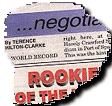

T& T sports behind the Times
By Terence
Hilton Clarke
(c)copyright
![]()
THE observations of Trinidad and Tobago coach, Grace Parkinson-Griffith, regarding her team’s inability to stand-up physically to its opponents during the recent World Netball Championship in New Zealand, served to highlight both a developmental and a cultural problem.
According to Parkinson-Griffith, net ball has become an increasingly physical discipline, one in which brawn has become almost as important as ability. It is against this background that she commented on the relatively small stature of her players, and the ease with which they were out muscled in one on one situations during the competition.
In fact one player, Lystra Zamore, was forced to miss two consecutive games with a shoulder injury, after being bowled over by her bigger marker during the meeting with Northern Ireland. Such incidents have moved the coach to confirm that weight training will now be a part of the team’s physical preparations in the future.
The above simply represents another reason as to why this country is beginning to flounder in a sporting world that is becoming increasingly professional. We are beginning to pay the price for our repeated failures to institute adequate sports development programs – a by-product of which is weight training.
The highly competitive nature of sport in places such as North America, Europe and Australia has led to a growing demand for proper physical conditioning. Football is a faster game than it was before. Basketball is much more intense. Tennis more demanding. Today's athletes need to be fitter, faster and stronger than those in past generations.
Newer and highly technological methods of physical preparation have created some obvious differences. First of all, it has been noticeable that athletes are actually bigger now than before. For instance, if one was to look at NBA basketball footage from last season (1998-99) and compare it to footage from, let's say, 1981, one of the first noticeable things is how much slimmer the players from back then appear. Today, the average professional basketball player is a neatly chiselled physical specimen: capable of holding off opponents in going for rebounds and loose passes.
The modern athlete is also faster than ever before. Even if one was capable of removing the stigma of performance enhancing drugs, it cannot be denied that today's top sprinters will still be clocking quicker times than those from twenty years ago.
Unfortunately, such modern means have not yet become institutionalized here in Trinidad and Tobago. While there seems to be a steady improvement in training, there is still a dearth of the high level physical preparation techniques that the more established sporting nations are already taking for granted.
But, this is not the only thing that is lacking. In the other regions, particularly North America, there is a solid foundation for these methods, manifested in the excellent physical education program that forms part of the school curriculums. Such programs are one of main reasons behind the athleticism exhibited by many top sportsmen and women from the United States. One only has observe the agility of the players on the world champion U.S. women's soccer team and compare them to their counterparts in Trinidad and Tobago.
Have we been putting sufficient emphasis on physical education in schools?
Based on my experience, probably not. While there were some teachers at my secondary school who “didn't make joke,” and would really put their students through a strenuous exercise regimen, there were others who were content to let us do whatever we wanted. Thus, some of us would go and play football, others went to play basketball and a handful played either tennis or badminton.
Over the years, I haven't heard anything to suggest that the situation is much different at other secondary schools: some of which do not even have adequate facilities and may even lack the teaching resources. Also, one may want to ask how highly do we prize physical education in schools. Does the Ministry of Education have any clear guidelines regarding physical education? Is physical education seen as something important, or is it just a recreational diversion for the students?
It will be interesting to see where the school administration stands on this issue.
go back up
|




